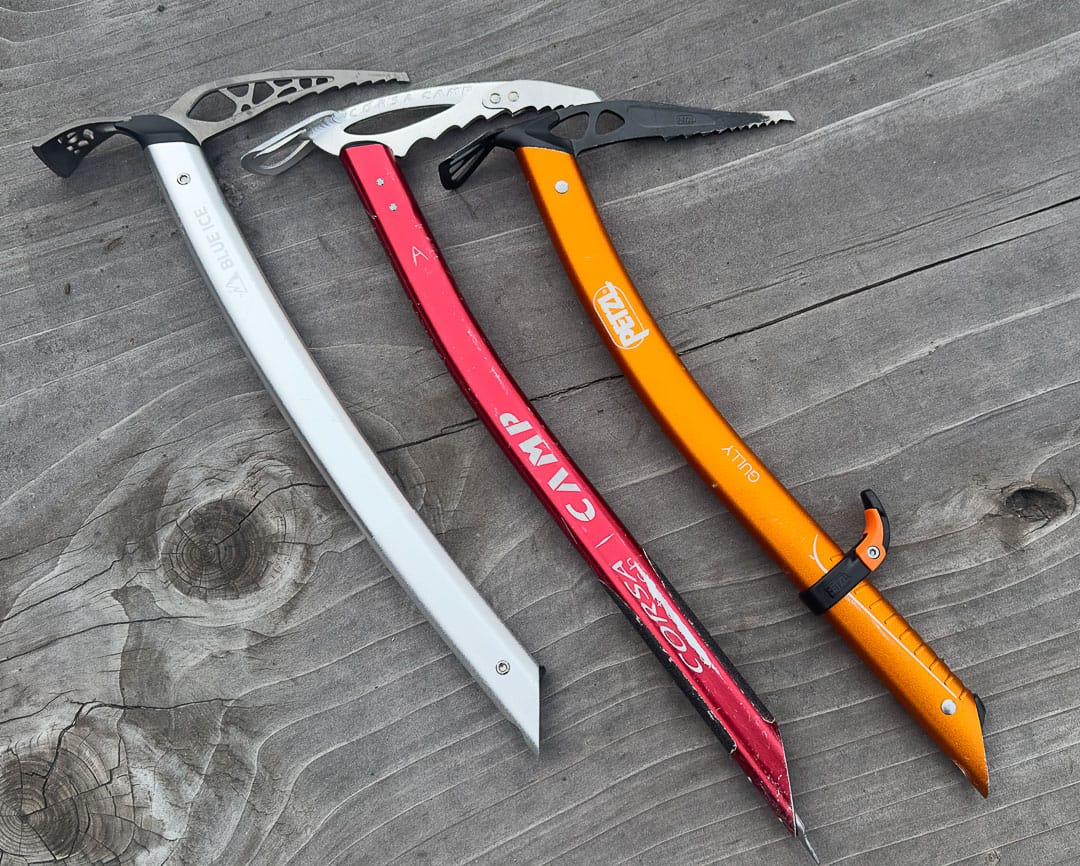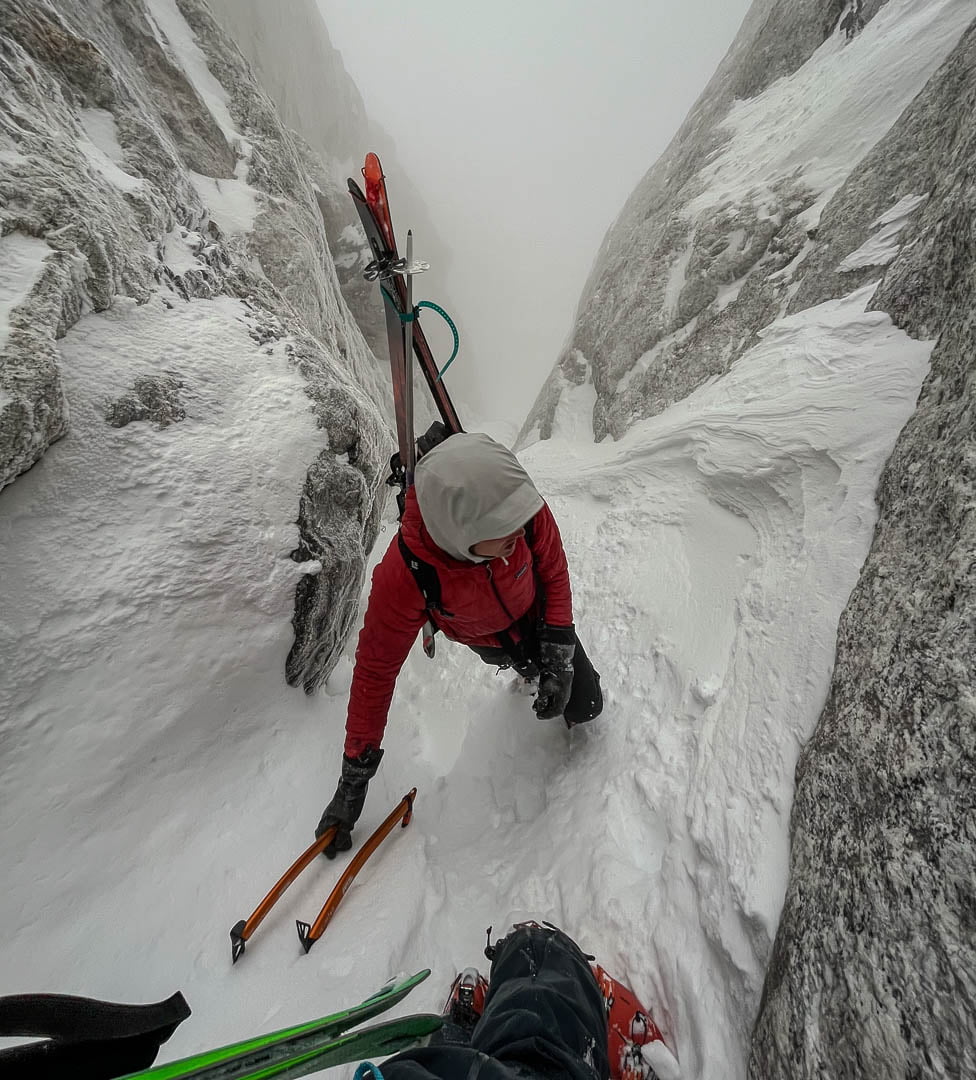The performance we seek from an ice axe varies widely depending on the day’s objective. Some days, all we need our axe to do is disappear in our pack, perhaps to come out in a steep or firm moment. On other days, we may spend hours with one or two axes in use, perhaps climbing steps of ice or rock. One tool can accomplish both of these tasks, but in our world of optimization and nuance, we can choose which tools we own or bring on a certain day based on the day’s needs. Let’s explore the tools we have been testing and what I have been enjoying (and not enjoying) in different scenarios.
In the THR testing/my quiver these days, I have the following tools: Petzl Gully (set), Blue Ice Akila (set), Black Diamond Venom LT (set), Camp Corsa Nanotech, Blue Ice Hummingbird, and Black Diamond Venom Hammer. No one needs this many tools, and I certainly don’t, but hopefully, my testing will help the reader narrow their options and build an efficient quiver of tools.
If you are new to ice axes, here’s our Ice Axes for Skiing (& riding): A Primer

One Tool to Rule Them All
The Petzl Gully is the reigning champion here. At 284g for the hammer (okay, time to admit that I forgot my adze on top of a mountain last spring), the Gully is competitively light and nails most of the important performance characteristics for skiing. The spike is sufficient in soft snow, the curved, narrow pick penetrates ice well, and the geometry works really well for moderate ice. What more is there to say? Downsides: The hammer is just okay—let’s go with sufficient for day-to-day piton whacking, but it is not ideal for significant anchor building or picket whacking. The spike (and 45cm length) isn’t great for long, lower angle, firm ascents; I have PNW volcanoes in mind here. Lastly, the lightweight makes for a bit more work when climbing ice—think more swings and more deflections on cold/hard ice. Adding pick weights can help here. Overall, the Gully has been a sufficient one-tool (well, often one pair of tools) quiver for many skiers worldwide. Alas, the market has followed Petzl’s lead and companies like Black Diamond and Blue Ice now make strong competitors for the Gully, each with their strengths and weaknesses.
Ultralight, Non-Technical Axe
This category serves many purposes. For most of us, it is (or should have been) our first ice axe (but instead, many of us probably opted for a BD Raven or equivalent…). I bring this type of axe for most classic, non-technical ski tours where you may be climbing on steep snow and want a bit more security than an upside-down ski pole, especially if things get firm. My first tool in this category was the Camp Corsa Nanotech—the classic red axe with a steel pick and spike riveted to the aluminum head/shaft. The Nanotech continues to be an excellent option, although the superlight head makes it perform pretty poorly at its upper limit of firm or steep terrain; the pick might just bounce off that little ice bulge you want to swing into.

This season, I secured a Blue Ice Hummingbird, which at 200g is both the lightest axe in my quiver and still quite functional. The tapered titanium pick sticks nicely in moderate ice or neve; otherwise, it is compact and functional in steep snow. The cutoff-style spike isn’t great on truly firm snow, but it has never been an issue for me (high dagger works well if you want extra security in that situation). The Petzl Ride is another option in this category, with attributes similar to the Hummingbird’s.
I have two opinions on this category that are at odds, but perhaps both worthwhile:
Alternate ending 1: As ultralight technical tools gain popularity and lose weight, this category becomes increasingly specialized. Perhaps the proper descriptor here is “late-stage weight weenie.” When all other avenues are exhausted, and you are ready to shed those last 60-80g from your ice axe weight some days, then maybe it’s time to check out an especially ultralight tool.
Alternate Ending 2: This is an appropriate starting point in your ice axe journey, and paired with a pinky rest and a more technical tool, it will get you up almost anything you want to climb/ski just fine.
“Ski Alpinism” Tools
Sure, the Gully climbs ice well, but damn, it is a pleasure to climb moderate ice with one swing sticks and feel stable and confident on your tools. Until the last few years, the next step up in “beef” from a Gully or equivalent was something like the Petzl Sumtec or BD Venom, at around 450g/tool.
Some (smart) readers will wonder, why climb ice to go skiing? But, with objectives like the Grand Teton’s Ford-Chevy-Stettner route getting more popular, ice climbing to ski is having its moment. The Blue Ice Akila (330g) is my tool of choice when “real” (ish) climbing is on the menu. They are a bit heavier than the Gully, but with the added mass comes a serious upgrade to the “beef” … the head of the tool. The pick is long and aggressive, the hammer is robust and bigger than the Gully, and the tools, as a whole, have a more solid feel. While this isn’t my day-to-day tool in the Tetons, I could see it being more of a daily driver when dealing with hard, glacial ice regularly in places like PNW volcanoes, Chamonix, etc. I think that the Akila Hammer will replace my BD Venom for Alaska guiding this spring—an inappropriate task for the Gully. The Akila feels up to the job and may make the Venom/Petzl Sumtec category somewhat obsolete in my world. The only downside to the Akila is the lack of replaceable picks/hammers, but I’ll take that for 120g savings.
Adaptable Quiver of One
While the Gully is a no-brainer, some of us who like to tinker may like the idea of a tool that is easy to modify and adapt to the day’s objective. This is a normal process with real/dedicated ice tools: swapping picks, adding pick weights, hammers, etc. The Black Diamond Venom LT brings that level of customization to the ultralight ski axe world. In its lightest configuration, it is close to the lightest options available at 220g. As far as execution/functionality in these various configurations, the Venom LT can be a little lackluster—the adze is small and blunt, the “classic” pick is comically short, the spike is excessively sharp and pokey (see my modification), and the geometry isn’t great for climbing steep ice.
Despite all this, I reach for the Venom LT regularly when I can optimize the configuration for the day’s task better than another “preconfigured” tool in my quiver. An example of such a configuration is for a top-down, technical descent with rappelling but minimal technical skiing. I might bring a Venom LT with the classic pick, no pommel, and a hammer added. My main use case here is a hammer to check/set pins and fixed gear, but it’s nice to have some ice axe functionality in case of an unexpected technical section. If you aren’t excited to tinker, this probably isn’t the tool for you, but for those of us with an optimization mindset, the Venom LT is a fun project.
Closing Thoughts
While it’s incredible to have so many choices and the ability to delve into the nitty gritty of each option, it is unrealistic and impractical to have a large quiver of tools for skiing. I’m curious to hear from folks in the comments: what is your ideal ice tool quiver? I like a Blue Ice Akila set and a Hummingbird for less technical days, but I was also pretty darn content with a set of Gullys for anything and everything for the last 4-5 years.






Leave a Reply
You must be logged in to post a comment.